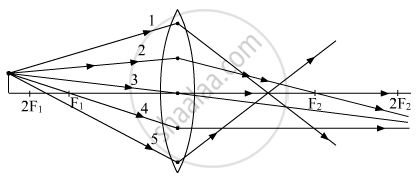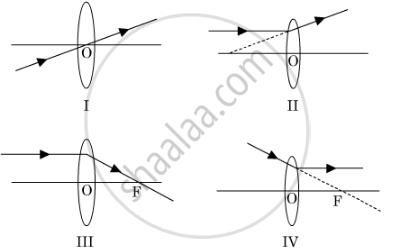Advertisements
Advertisements
Question
Out of the five incident rays shown in the figure find the three rays that are obeying the laws of refraction and may be used for locating the position of image formed by a convex lens:
(A) 1, 2 and 3
(B) 2, 3 and 4
(C) 3, 4 and 5
(D) 1, 2 and 4
Solution
(B)
Rays (2), (3) and (4) obey the laws of refraction.
Ray parallel to the principal axis passes through the second focus of the lens.
Ray passing through the optical center goes undeflected.
Ray passing through the first focus of the lens goes parallel to the principal axis.
APPEARS IN
RELATED QUESTIONS
A student has obtained a magnified image of a flame on a screen using a convex lens. To draw the corresponding ray diagram to show the image formation, which of the following two rays whose paths after refraction are shown, should he select ?

(A) I and II
(B) II and III
(C) III and IV
(D) I and III
One-half of a convex lens is covered with a black paper. Will this lens produce a complete image of the object? Verify your answer experimentally. Explain your observations.
An object 5 cm in length is held 25 cm away from a converging lens of focal length 10 cm. Draw the ray diagram and find the position, size and the nature of the image formed.
An object is placed at a distance of 15 cm from a convex lens of focal length 20 cm. List four characteristics (nature, position, etc.) of the image formed by the lens.
How would a pencil look like if you saw it through How would a pencil look like if you saw it through
A convex lens of focal length 10 cm is placed in contact with a concave lens of focal length 20 cm. The focal length of this combination of lenses will be:
(a) +10 cm
(b) +20 cm
(c) −10 cm
(d) −20 cm
What type of lens is used to correct
hypermetropia
What kind of lens is used to correct
long-sightedness?
A convex lens of focal length 20 cm can produce a magnified virtual as well as real image. Is this a correct statement? If yes, where shall the object be placed in each case for obtaining these images?
